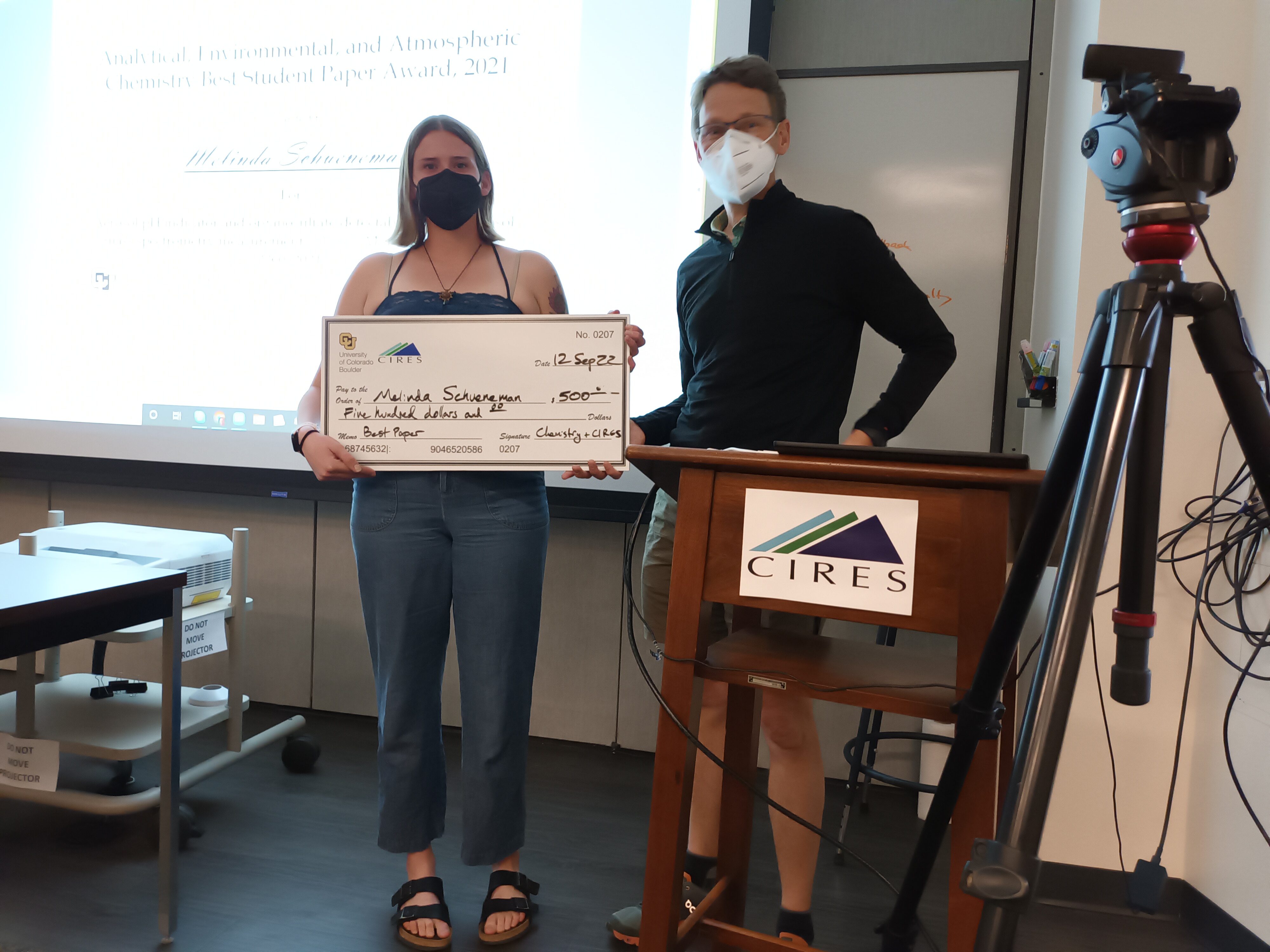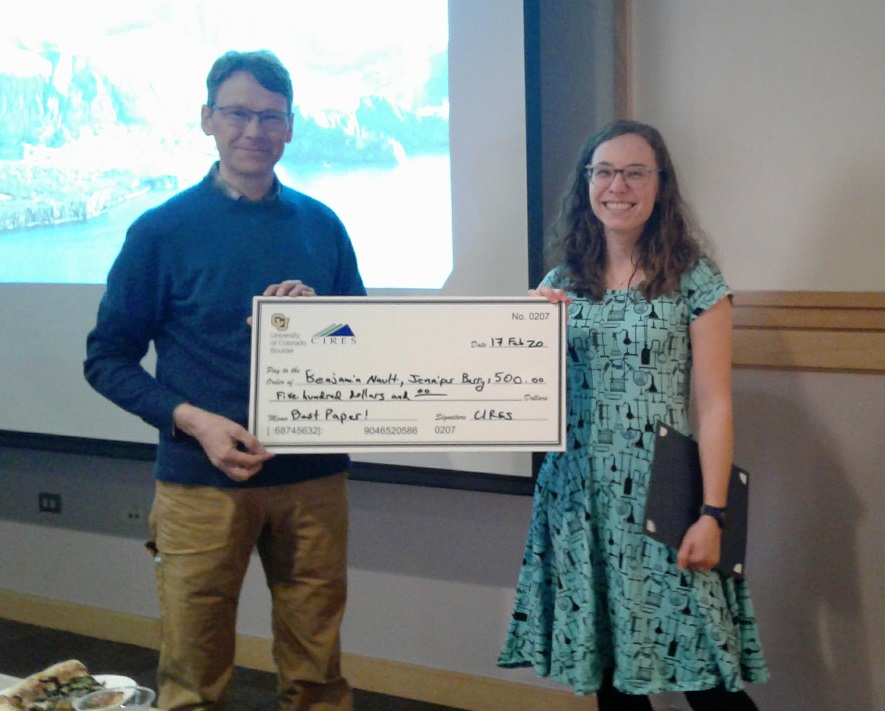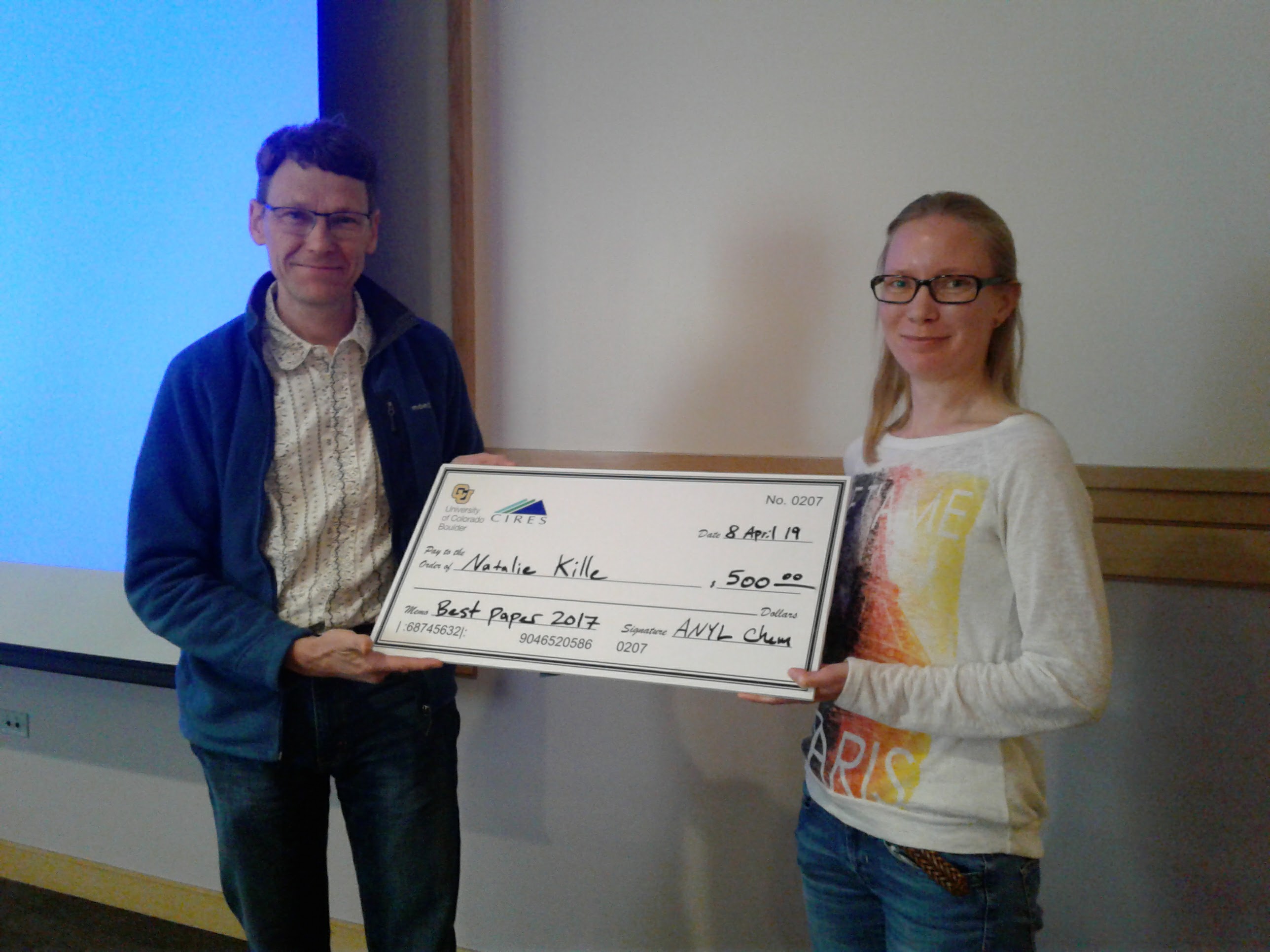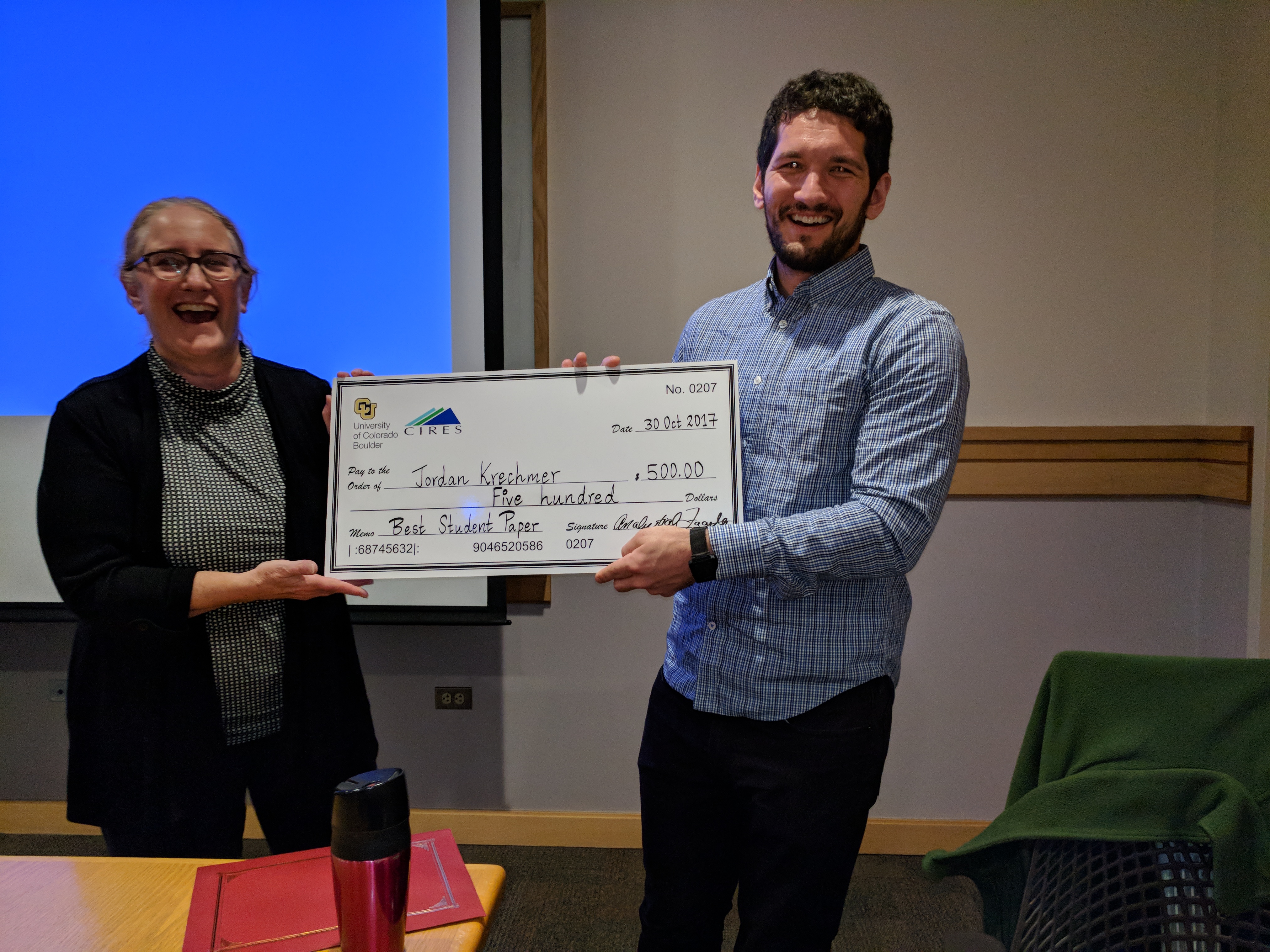Difference between revisions of "ANYL Award"
From Jimenez Group Wiki
(→Best Papers of 2020) |
(→Best Papers of 2020) |
||
| Line 11: | Line 11: | ||
* <b>Postdoc:</b> Zhe Peng, for [https://doi.org/10.1039/C9CS00766K Radical chemistry in oxidation flow reactors for atmospheric chemistry research]. Z. Peng, J.L. Jimenez, Chem. Soc. Rev., 49, 2570 - 2616, 2020. doi: 10.1039/C9CS00766K | * <b>Postdoc:</b> Zhe Peng, for [https://doi.org/10.1039/C9CS00766K Radical chemistry in oxidation flow reactors for atmospheric chemistry research]. Z. Peng, J.L. Jimenez, Chem. Soc. Rev., 49, 2570 - 2616, 2020. doi: 10.1039/C9CS00766K | ||
| + | |||
| + | [[File:2022_Mindy.jpg|175px|thumb]] | ||
== Best Papers of 2019 == | == Best Papers of 2019 == | ||
Revision as of 16:07, 29 September 2022
Contents
Past Winners of the Awards
Best Papers of 2021
- Graduate Student: Mindy Schueneman, for Aerosol pH indicator and organosulfate detectability from aerosol mass spectrometry measurements. M.K. Schueneman, B.A. Nault, P. Campuzano-Jost, D.S. Jo, D.A. Day, J.C. Schroder, B.B. Palm, A. Hodzic, J.E. Dibb, J.L. Jimenez. Atmos. Meas. Tech., 4, 2237–2260, https://doi.org/10.5194/amt-14-2237-2021, 2021.
- Postdoc: Derek Price, for Sources of Gas-Phase Species in an Art Museum from Comprehensive Real-Time Measurements. D.J. Price, D.A. Day, D. Pagonis, H. Stark, A.V. Handschy, L.B. Algrim, S.L. Miller, J.A. de Gouw, P.J. Ziemann, J.L. Jimenez. ACS Earth Space Chem., 5, 9, 2252–2267, https://pubs.acs.org/doi/10.1021/acsearthspacechem.1c00229, 2021.
Best Papers of 2020
- Graduate Student: Mitchell Alton, for Atmospheric Chemistry of Volatile Methyl Siloxanes: Kinetics andProducts of Oxidation by OH Radicals and Cl Atoms. M.W. Alton, E.C. Browne, Environ. Sci. Technol. 2020, 54, 10, 5992–5999. https://doi.org/10.1021/acs.est.0c01368
- Postdoc: Zhe Peng, for Radical chemistry in oxidation flow reactors for atmospheric chemistry research. Z. Peng, J.L. Jimenez, Chem. Soc. Rev., 49, 2570 - 2616, 2020. doi: 10.1039/C9CS00766K
Best Papers of 2019
- Graduate Student: Theodore Koenig, for Quantitative detection of iodine in the stratosphere. Koenig, T.K., Baidar S., Campuzano-Jost, P., Cuevas, C.A., Dix, B., Fernandez, R.P., Guo, H., Hall, S.R., Kinnison, D., Nault, B.A., Ullmann, K., Jimenez, J.L., Saiz-Lopez, A. and Volkamer R.: Quantitative Detection of Iodine in the Stratosphere, Proc. Nat. Acad. Sci., doi: 10.1073/pnas.1916828117, 2020. (in press 2019)
- Postdoc: Xiaoxi Liu, for Direct measurements of semi-volatile organic compound dynamics show near-unity mass accommodation coefficients for diverse aerosols. X. Liu, D.A. Day, J.E. Krechmer, W. Brown, Z. Peng, P.J. Ziemann, J.L. Jimenez. Comms. Chem., 2, 98, 2019. doi.org/10.1038/s42004-019-0200-x
Best Papers of 2018
- Graduate Student: Jennifer Berry, for Laser Ablation-Aerosol Mass Spectrometry-Chemical Ionization Mass Spectrometry for Ambient Surface Imaging. J.L. Berry, D.A. Day, T. Elseberg, B.B. Palm, W. Hu, A. Abdelhamid, J.C. Schroder, U. Karst, J.L. Jimenez, E.C. Browne. Anal. Chem. 90, 4046–4053, doi:10.1021/acs.analchem.7b05255, 2018.
- Postdoc: Benjamin Nault, for Secondary Organic Aerosol Production from Local Emissions Dominates the Organic Aerosol Budget over Seoul, South Korea, during KORUS-AQ B.A. Nault, P. Campuzano-Jost, D.A. Day, J.C. Schroder, B. Anderson, A.J. Beyersdorf, D.R. Blake, W.H. Brune, Y. Choi, C.A. Corr, J.A. de Gouw, J. Dibb, J.P. DiGangi, G.S. Diskin, A. Fried, L.G. Huey, M.J. Kim, C.J. Knote, K.D. Lamb, T. Lee, T. Park, S.E. Pusede, E. Scheuer, K.L. Thornhil, J.-H. Woo, J.L. Jimenez. . Atmos. Chem. Phys., 18, 17769-17800, 2018. https://doi.org/10.5194/acp-18-17769-2018.
Best Papers of 2017
- Graduate Student: Natalie Kille, for The CU Mobile Solar Occultation Flux Instrument: structure functions and emission rates of NH3, NO2 and C2H6. Kille, N., S. Baidar, P. Handley, I. Ortega, R. Sinreich, O. R. Cooper, F. Hase, J. W. Hannigan, G. Pfister, and R. Volkamer. Atmos. Meas. Techn. 10, 363-392, 2017. doi:10.5194/amt-10-373-2017.
- Postdoc: Shang Liu, for Gas-phase carboxylic acids in a university classroom: abundance, variability, and sources. S. Liu, S.L. Thompson, H. Stark, P.J. Ziemann, J.L. Jimenez. Environ. Sci. Technol., 51, 5454–5463, doi:10.1021/acs.est.7b01358, 2017.
Best Paper of 2016
- Graduate Student: Jordan E. Krechmer, for Quantification of gas-wall partitioning in Teflon environmental chambers using rapid bursts of low-volatility oxidized species generated in-situ. Jordan E. Krechmer, D. Pagonis, P.J. Ziemann, and J.L. Jimenez. Environmental Science & Technology, 50, 5757–5765, doi:10.1021/acs.est.6b00606, 2016.
Best Paper of 2015
- Graduate Student: Ryan D. Davis: Contact efflorescence as a pathway for crystallization of atmospherically relevant particles. Ryan D. Davis, , Sara Lance, Joshua A. Gordon, Shuichi B. Ushijima, and Margaret A. Tolbert. Proceedings of the National Academy of Sciences, 2015 112 (52) 15815-15820; doi:10.1073/pnas.1522860113
- Graduate Student: Sean Coburn: Measurements of Diurnal Variations and Eddy Covariance (EC) Fluxes of Glyoxal in the Tropical Marine Boundary Layer: Description of the Fast LED-CE-DOAS instrument. S. Coburn, I. Ortega, R. Thalman, B. Blomquist, C. W. Fairall, and R. Volkamer, Atmospheric Measurement Techniques, 7, 3579–3595, 2014.
- Graduate Student: Allison Reed Harris: Photochemical Kinetics of Pyruvic Acid in Aqueous Solution. A. E. Reed Harris, B. Ervens, R. K. Shoemaker, J. A. Kroll, R. J. Rapf, E. C. Griffith, A. Monod, and V. Vaida. Journal of Physical Chemistry A, 118, 8505–8516, 2014.
- Graduate Student: Gregory Schill: Heterogeneous Ice Nucleation on Simulated Sea-Spray Aerosol Using Raman Microscopy. G. P. Schill, D. O. De Haan, and M. A. Tolbert, Environmental Science and Technology, 48, 1675–1682, 2014.
CIRES Env. Chem. Division Best Student Paper Award
Rules for the Competition
- (1) The paper must have been published in final form and/or have an official acceptance date during the past calendar year. Non-peer reviewed papers are not eligible, including “discussions” papers. A given paper can only be submitted for the Award once, even if it is eligible in two consecutive years.
- (2) The first author of the paper must be (have been) a PhD or Masters student in one of the groups under CIRES Environmental Chemistry when the paper was submitted. This includes CIRES/ANYL students working for faculty in other divisions, departments or in national labs. It also includes students who have graduated, as long as the paper was part of their graduate research and was published during the past calendar year. A given student can only win this competition once.
- (3) The first author of the paper should submit the following materials to the ANYL Graduate Advisor via email:
- PDF of the paper in final form
- A paragraph (limited to 250 words) stating the significance and impact of the work and their role in the work described in the paper
- (4) The criteria for the Award will include the novelty and importance of the results, the quality of the presentation, and the quality of the journal.
- (5) The CIRES EnvChem faculty will vote to choose one paper. Details below.
- (6) The Award will be presented at ANYL seminar, and will consist of $500 and a Certificate
CHEM ANYL Division Best Postdoc & Research Scientist Paper Award
Rules for the Competition
- All rules are the same as for the graduate student award, with the following exceptions:
- (2) The first author of the paper must be (have been) a postdoctoral researcher or research scientist in the CHEM ANYL Division when the paper was submitted. This includes people who have moved on from CU, as long as the paper was part of their research at CU, and was published during the past calendar year. A given person can only win this competition once.
- (5) The CHEM ANYL faculty will vote to choose one paper. Details below.
Detailed Rules for Faculty Voting (for both competitions)
- (1) Each faculty votes per the rules, by ranking the papers in a category as 1st (best), 2nd etc. As is standard to avoid conflicts-of-interest, faculty cannot vote on papers where they are coauthors. If an advisor does not vote, the papers from his/her advisees will not be eligible for the Award.
- (2) The final score is calculated by summing the individual faculty scores for a paper, and then dividing by the number of faculty that voted on that paper. E.g. if a paper is ranked 1st by one faculty member and 2nd by another (and only those 2 faculty voted), it has 3 total points, and a final score of 3 / 2 = 1.5.
- (3) The paper with the lowest final score wins.
- (4) If one or more papers are within 10.0% of the score of the winning paper (calculated as (2nd - winner) / winner), then those papers also win. Otherwise there is only one winner.





